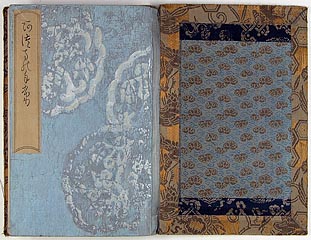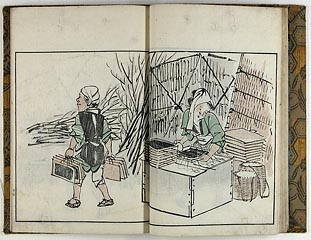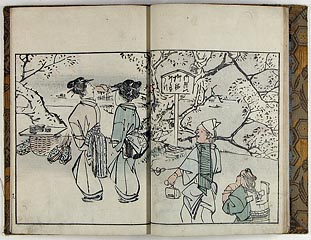|
return to the archive's EHON overview |
 of items sold in the past |
view ALL book pages |
|
return to the archive's EHON overview |
 of items sold in the past |
view ALL book pages |
| CHINNEN, Onishi (1792 - 1851) |
"Azuma no teburi"
'Customs of the Eastern Capital' |
 
|
Publishing details: Signed: Chinnen sensei ga Publisher: Kobayashi Shibei, Osakaya Genbei, Edo Dated: Bunsei, 12th month (autumn 1829) Size: obon (c. 28 x 18 cms / c. 11" x 7") Collation: complete in one vol.; original covers (blueish-gray with silver- 'mica' patterns) and title slip. Inside front cover: title page; introduction: 6 pp.; table of contents: 1 p.; illustrations: 50 pp. (25 dp. ills.), numbered: 1-26; followed by 6 pp. of text; inside back cover: colophon (more on the pictures page). Condition: Exceptionally fine impression and color , in very good to fine condition, in spite of some lightly backed wormholes, mainly in upper margins, which are much less obvious in reality than in the photographs. - The book, including the original covers, comes bound in decorative brocade covers, which represent a good protection of this fine book. Provenance: former Charles Gillot collection. For more information, please read below. "Azuma no tebori" is one of the masterpieces of shijo-style book illustration. BOOK AVAILABLE FOR SALE, SHOWN IN THE MAIN GALLERY'S >> Illustrated Books section << |
 
|
Azuma no teburi is discussed in detail in Jack Hillier's ground-breaking studies of the Japanese illustrated book and those in'shijo'- and 'nanga-style in particular. For these and numerous other publications, pls. see the reference list at the bottom of this page. Quote from "Art of the Japanese book": "... By its title Azuma no teburi set out to analyse the 'manners of the town', 'Azuma' being a name for Edo with a high-sounding, venerable ring, and Chinnen, in the manner of the artists of the nenju-gyoji books ..., picking his way among residents, people busy at their trades and occupations or casual loafers in street or teahouse, varying the scene from main thoroughfare to suburban river-ban, and the weather from the languor of high summer to the violent rainstorm of autumn. Throughout, Chinnen displays a free-and-easy brush-style, and the print-makers closely followed the washes he laid down, giving them a limpidity peculiar to the block-applied colours. There is no word of descriptive text on the prints: the drawings were explicit; each viewer interpreted them according to his own experience and knowledge of the city, though there was a table of contents that gave the locations for those that wished to verify them. One of the finest of the double-page prints is 'The first shrine visit of the New Year', with a group of three figures at the head of a little procession, another man following behind with a boy who bears over his shoulders twigs hung with decorative baubles, the concomitant of the shrine visit. We admire the intimacy and informality of the group of three, whose hoods gave the artist such a wonderful opportunity to show the deftness of his brush in imposing a telling accent to the drawing. 'Cherry-viewing along the Sumida River', shows another family outing whose movement to the left is portrayed by Chinnen with the same kind of artifice that the early narrative makimono painters used so frequently, the diagonal disposition of the figures accentuated by the border cutting into and dissecting the form entering at the right. Once again, we feel the blandness of Chinnen's manner, without the harshness of Suiseki (Suiseki, Sato; fl. c. 1805-40), or the mordant satire of Shuho (Shuho, Aoi/Saito; 1769-1859). There are shishimai performers, hawkers, mountebanks, the inevitable fisherman trawling, a men's bathhouse, kago porters, nori-makers, fullers, a tinker mending a pot while a boy whips a top so that it flies right outside the upper border of the print; whithin doors, a girl applies moxa to the back of an old man who unconcernedly continues reading his book. All quite everyday, non-sensational events, with no accompanying text: yet there was a market for such a book, and the Edo-dwellers clearly appreciated it for Chinnen's artistry, for the way he recorded their life-style." (Jack Hillier) Reference: J. Hiller: "Art of the Japanese Book", pp. 768-70, pl; "The Unhibited Brush", p. 315-20 (fig. 244-47). F. Rumpf, "Meister des Japanischen Farebholzschnittes"; Berlin, 1924; pl. 17. S. Sorimachi, "Catalogue of Japanese illustrated books and manuscripts in the Spencer collection of the New York Public Library"; 1978; p. 128, no. 567. Toda, p. 395; Mitchell, p. 214; Brown, p. 106; Duret no. 504; Holloway no. 16 (pl. 77); Gillot no. 889; Hayashi no. 1646; Isaac no. 465 (pl. II); Javal I, no. 122 (pl. VIII); Odin no. 186; Hillier et Smith no. 133. |